2017 AUDI A3 SEDAN warning
[x] Cancel search: warningPage 263 of 400

CXl CXl .... N ,.__
N .... 0 N > 00
Although your Audi is equipped with airbags, you
still hav e to wear the safety belts provided. Front
airbags, for example, are activated only in some
frontal collisions. The front airbags are not acti
vated in all frontal collisions, in side and rear col lisions, in roll overs or in cases where there is not
enough deceleration through impact to the front
of the vehicle . The same goes for the other airbag
systems in your Audi . So, always wear your safety
belt and make sure everybody in your vehicle is
properly restrained!
Important safety instructions about safety
belts
Safety belts must always be correctly positioned
across the strongest bones of your body.
.,. Always wear safety belts as illustrated and de
scribed in this chapter.
.. Make sure that your safety belts are always
ready for use and ar e not damag ed.
A WARNING
Not wearing safety belts or wearing them im·
properly increases the risk of serious personal
injury and death . Safety belts can work only
when used correctly.
- Always fasten your safety belts correctly be
fore driving off and make sure all passen gers are correctly restrained .
- For maximum protection, safety belts must always be positioned properly on the body.
- Never strap more than one person, includ
ing small children, into any belt .
- Never place a safety belt over a child sitting
on your lap.
- Always keep feet in the footwell in front of
the seat while the vehicle is being driven.
- Never let any person ride with their feet on
the instrument panel or sticking out the
window or on the seat.
- Never remove a safety belt while the vehicle
is moving. Doing so will increase your risk of
being injured or killed.
- Never wear belts twisted.
- Never wear belts over rigid or breakable ob- jects in or on your clothing, such as eye
Safety belts
glasses, pens, keys, etc., as these may cause
injury.
- Never allow safety belts to become dam
aged by being caught in door or seat hard
ware.
- Do not wear the shoulder part of the belt
under your arm or otherwise out of position.
- Several layers of heavy clothing may inter
fere with correct positioning of belts and re duce the overall effectiveness of the system .
- Always keep belt buckles free of anything
that may prevent the buckle from latching
securely.
- Never use comfort clips or devices that cre
ate slack in the shoulder belt. However, spe
cial clips may be required for the proper use
of some child restraint systems .
- Torn or frayed safety belts can tear, and
damaged belt hardware can break in an acci
dent . Inspect belts regularly.
If webbing,
bindings, buckles, or retractors are dam
aged , have belts replaced by an authorized
Audi dealer or qualified workshop.
- Safety belts that have been worn and loaded
in an accident must be replaced with the
correct replacement safety belt by an au
thorized Audi dealer. Replacement may be
necessary even if damage cannot be clearly
seen. Anchorages that were loaded must al
so be inspected.
- Never remove, modify, disassemble, or try
to repair the safety belts yourself.
- Always keep the belts clean. Dirty belts may
not work properly and can impair the func
tion of the inertia reel
¢ table Interior
cleaning on page 349.
261
Page 264 of 400
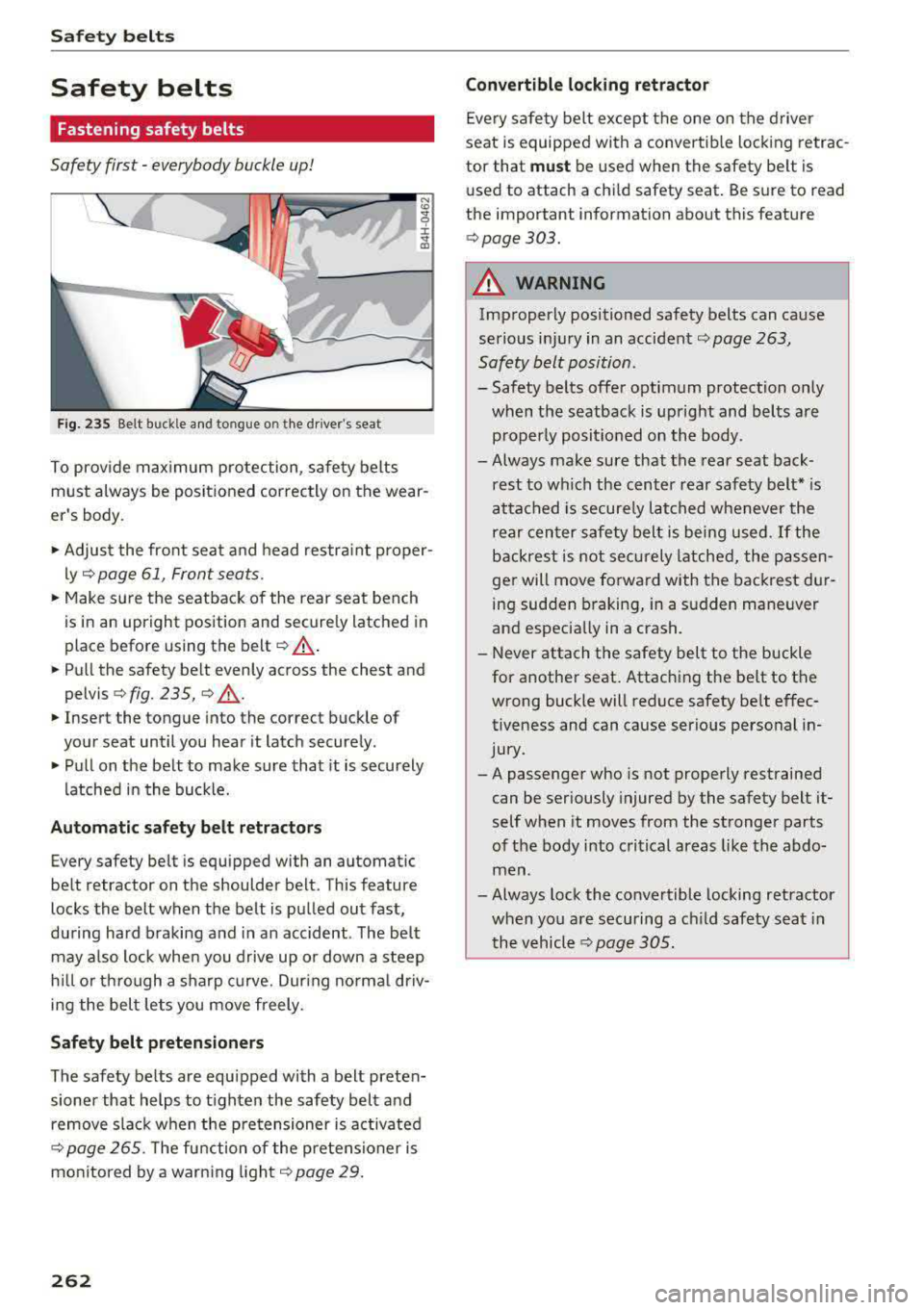
Safe ty belts
Safety belts
Fastening safety belts
Safety fir st -everybody bu ckle up!
Fig. 235 Belt buckle an d tongue o n the driver's seat
To prov ide max imum protection, safety belts
must always be positioned correctly on the wear
er's body .
• Adjust the front seat and head restra int proper
ly ¢
page 61 , Front seats .
• Make sure the seatback of the rear seat bench
is in an upright position and secure ly latched in
place before us ing the
belt ¢,&. .
• Pull the safety belt evenly across the chest and
pelv is
¢fig. 235, ¢ ,&. .
• Insert the tongue into the correct buckle of
your seat until you hear it latch securely .
• Pull on the belt to make sure that it is securely
latched in the buck le.
Autom ati c safet y belt retr actors
Every safety belt is equipped with an automatic
belt retractor on the shoulder belt . This feature
locks the belt when the belt is pulled out fast,
during hard braking and in an accident . The belt
may a lso lock when you drive up or down a steep
h ill or th rough a sharp curve. Dur ing no rmal driv
ing the bel t lets you move freely.
Safe ty belt pret ension ers
The safety belts are equipped with a belt preten
sioner that helps to t ighten the safety belt and
remove slack when the pre tensioner is activated
¢ page 265. T he fu nction of the pretensioner is
monitored by a warning light ¢
page 29.
262
Convertibl e lock ing r etractor
Every safety belt except the one on the driver
seat is equipped with a convertib le lock ing retrac
tor that
mu st be used when the safety belt is
used to attach a child safety seat . Be sure to read
the important information about thi s feature
¢ page 303.
A WARNING
Improperly positioned safety belts can cause
serious injury in an accident ¢
page 263,
Safety belt position .
- Safety belts offer optimum protection only
when the seatback is upright and belts are properly posit ioned on the body .
- Always make sure that the rear seat back
rest to which the center rear safety belt* is
attached is securely latched whenever the
rear center safety belt is being used.
If the
backrest is not sec urely latched, the passen
ger will move forward with the back rest du r
ing sudden braking, in a sudden maneuver
and especia lly in a crash.
- Never attach the safety belt to the buckle for another seat. Attaching the belt to the
wrong buckle will reduce safety be lt effec
tiveness and can cause serio us personal in
jury.
-A passenger who is not properly restrained
can be seriously injured by the safety belt it
self when it moves from the stronger parts
of the body into critical areas like the abdo
men .
-Always lock the convertible locking retractor
when you are securing a c hild safety seat in
the vehicl e
¢page 305.
Page 265 of 400

a, a, ..... N
" N ..... 0 N > 00
Safety belt position
Correct belt position is the key to getting maxi
mum protection from safety belts .
~
"' l'-9 r .. a,
Fig. 236 Safety bel t pos it io n
Standard feat ures on your vehicle he lp you ad just
the posit ion of the safety belt to match your body
size .
- belt he igth adj ustmen t for the front seats *,
- height-adjustable front seats.
.&, WARNING
Improperly pos it ioned safety be lts ca n ca use
ser ious personal inj ury in an accident .
- T he shoulder belt sho uld lie as close to the
cen ter of the colla r bone as possible and
should fit we ll on the body. Hold t he belt
above the latch tong ue a nd pu ll it evenly
across the chest so that it sits as low as pos
sible on the pelvis and there is no press ure
on the abdomen . The belt should always fit
snugly
Q fig. 236. Pull on the belt to tighten
if necessary.
- The lap belt portion of the safety belt must
be pos itioned as low as possib le across pel
vis and never over the abdomen. Make sure
the belt lies flat and snug
Q fig . 236 . Pull on
th e belt to tighten if necessary.
- A loose-fitt ing safety belt can cause ser ious
injuries by shift ing its pos ition on you r body
from the st rong bones to more vu lne rable,
soft tiss ue a nd cause ser ious injury.
- Always read and heed all WARN INGS and
other importa nt inform ation
<=? page 261.
Safet y bel ts
Pregnant women must also be correctly
restrained
The best way to protect the fetus is to make sure
that expectant mothers always wear safety bel ts
correctly
-throughout the pregnancy.
F ig. 237 S af ety belt position duri ng pregnancy
To provide maximum protection, safety belts
must always be positioned correctly on the wear
er's
body ¢ page 263 .
.. Adjust the front seat and adjustable head re
straint*
c orrec tly¢ page 61, Front sea ts .
.,. Pull the safety belt evenly across the chest so
that it sits as low as possible on the pelvis and
there is no pressure on the abdomen
Q fig. 237 , ¢ .&,.
.,. Insert the tongue into the co rrect buc kle of
your sea t until yo u hear i t latch secu rely.
.,. Pull on the belt to make sure that it is sec urely
latched in the buckle.
_& WARNING
Improperly positioned safety belts can cause
serious pe rsonal injury in an acc ident.
-Expectant mothers must always wear the
lap portion of the safety belt as low as pos
sible across the pe lvis and below the round
ing of the abdomen.
- Always read and heed all WARNINGS and
other important
i nformation¢ .&. in Fasten
ing safety belts on page 262 .
263
Page 266 of 400
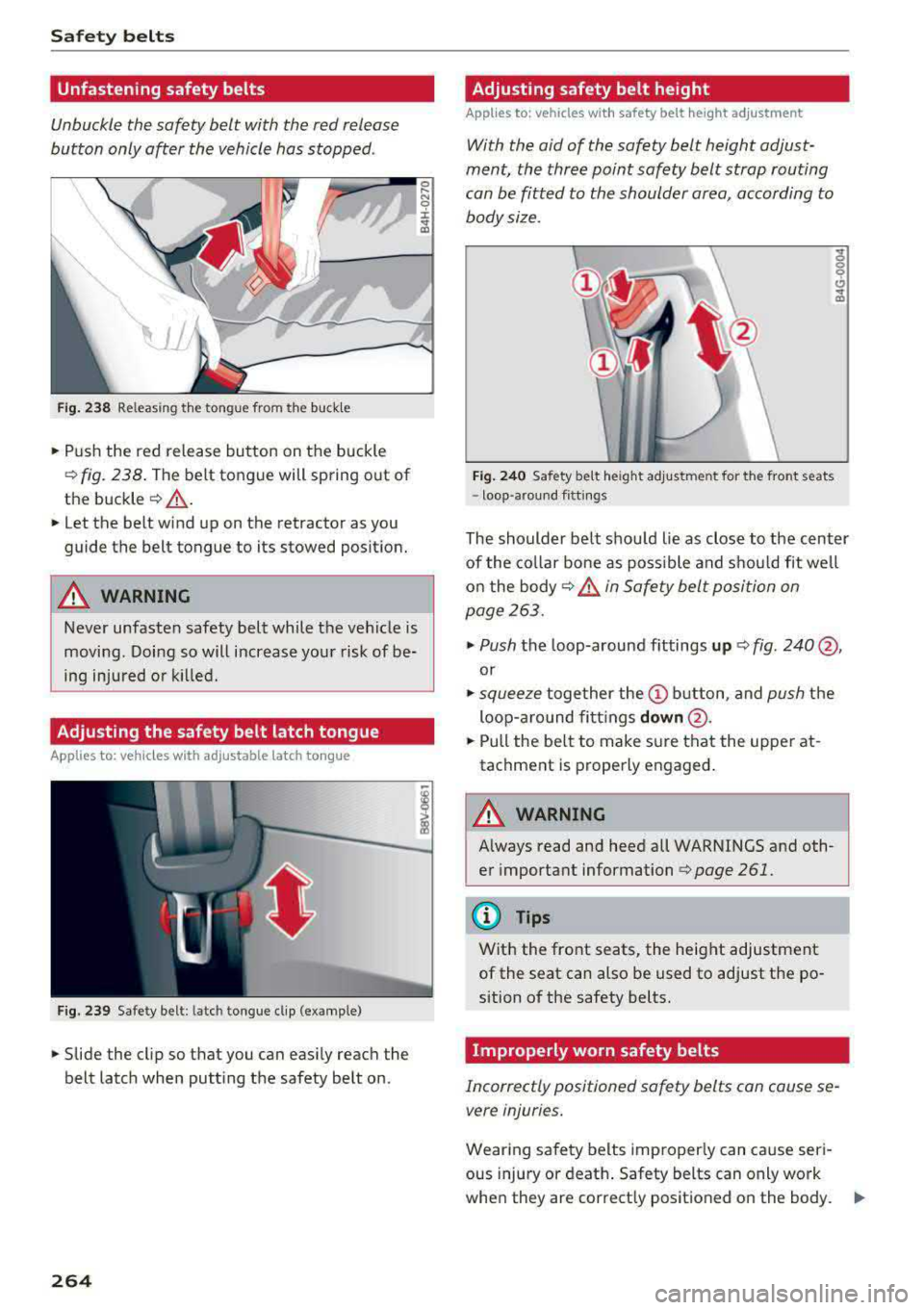
Safety belts
Unfastening safety belts
Unbuckle the safety belt with the red release
button only after the vehicle has stopped.
Fig. 238 Releasing t he tongue from the buckle
.. Push the red release button on the buckle
q fig. 238. The belt tongue will spring out of
the buckle
q ,& .
.. Let the belt wind up on the retractor as you
guide the belt tongue to its stowed position.
A WARNING
Never unfasten safety belt while the vehicle is
moving. Doing so will increase your risk of be
ing injured or killed.
Adjusting the safety belt latch tongue
Applies to: vehicles with adjustable latch tongue
Fig. 239 Safety belt: latch tongue cl ip (example)
.. Slide the cl ip so that you can easily reach the
belt latch when putt ing the safety belt on .
264
a
~ 0 :i: .. 0J
Adjusting safety belt he ight
Applies to: vehicles with safety belt height adjustment
With the aid of the safety belt height adjust
ment, the three point safety belt strap routing
can be fitted to the shoulder area, according to
body size .
Fig. 240 Safety belt heigh t adjustment for the front seats
-loop-around fittings
The shoulder belt shou ld lie as close to the center
of the collar bone as poss ible and shou ld fit well
on the body
q .&. in Safety belt position on
page 263.
.,. Push the loop-around fittings up ¢ fig. 240 @,
or
.,. squeeze together the @ button, and push the
loop-a round fittings
down @.
.. Pull the belt to make sure that the upper at
tachment is properly engaged.
A WARNING
Always read and heed all WARNINGS and oth
er important information
q page 261.
(D Tips
With the front seats, the height adjustment
of the seat can also be used to adjust the po
sition of the safety belts.
Improperly worn safety belts
Incorrectly positioned safety belts can cause se vere injuries.
Wearing safety belts imp roper ly can cause seri-
ous injury or death. Safety belts can only work
when they are correct ly positioned on the body.
..,.
Page 267 of 400

CXl CXl
Improper seating positions reduce the effective
ness of safety be lts and will even increase the
risk of injury and death by mov ing the safety belt
to critical areas of the body. Improper seating positions also increase the risk of serious injury
and death when an airbag deploys and strikes an
occupant who is not in the correct seat ing pos i
tion . A driver is respons ible for the safety of a ll
vehicle occupants and espec ia lly for children.
Therefore:
"' Never permit anyone to assume an incorrect
s itting position in the veh icle wh ile trave ling
c:> & .
A WARNING
Improperly worn safety belts increase the risk
o f serious personal injury and death whenever
a vehicle is being used .
- Always make sure tha t all vehicle occupants
are correctly restrained and stay in a correct
seating position whenever the vehicle is be
ing used.
- Always read and heed all WARNINGS and
other important information
c:> page 261.
Belt tensioners
How safety belt pretensioners work
In front, side and rear-end collisions above a
particular severity and in a rollover , safety belts
are tensioned automatically .
Reversible safety belt ten sioners
The safety belts on the front seats are equipped
with power reversible tensioners. The following
functions are available when the driver's/front passenger's safety belts are fastened:
- In certain driving situations, the safety belts
may tighten with a reversible tens ion ing func
t ion
i::>page 133 .
- The safety belts may a lso tighten with this re
versib le tensioning function in minor collis ions.
Pyrotechnic safety b elt pr eten sion ers
;:::: The safety belts are equipped with sa fety belt r---
~ pretensioners . The system is activated by sensors 0
~ in front, side and rear-end co llisions of great se-oo
Safet y be lts
verity and in a rollover. This tightens the belt and
takes up belt
slack ¢&. in Service and disposal of
safety belt pretensioner on page 266.
Taking up
the slack helps to reduce forward occupant movement during a collision.
A WARNING Co---
- It is poss ible for the pretensioners to deploy
i n correctly.
- The pyrotechnic system can only provide
protection for one collision. If the pyrotech
n ic pretens ioners deploy, the pretensioning
sys tem must be replaced.
@ Tips
The pyrotechn ic safety belt pretensioners can
o nly deploy once.
- The safety belt pretensioners do not deploy
in minor frontal, side and rear-end colli
sions .
- A fine dust is re leased when the pyrotechnic
safety belt pretensioners deploy . This is nor
mal and is not caused by a fi re in the ve hi
cle.
- The relevant safety requirements must be
observed when the vehicle or components
of the system are scrapped. A q ualified
dealership is familiar with these regulat io ns
and wi ll be pleased to pass on the informa
tion to you.
- Be sure to observe all safety, envi ronment al
and other regulat ions if the vehicle or in di
vidua l parts of the system, particularly the
safety belt or airbag, are to be disposed . We
recommend you have yo ur authorized Aud i
dealer perform this service for you.
Service and disposal of safety belt preten
sioner
T he safety belt p retensioners are pa rts of the
safety belts on your Aud i. Insta llin g, removing,
servicing or repair ing of be lt pretens io ners can
damage the safety belt system and prevent it
from wo rking correctly in a co llision .
T he re are some important things you have to
k now to make s ure tha t the effectiveness of the
system will not be impaired and that discarded
IJI-
265
Page 268 of 400
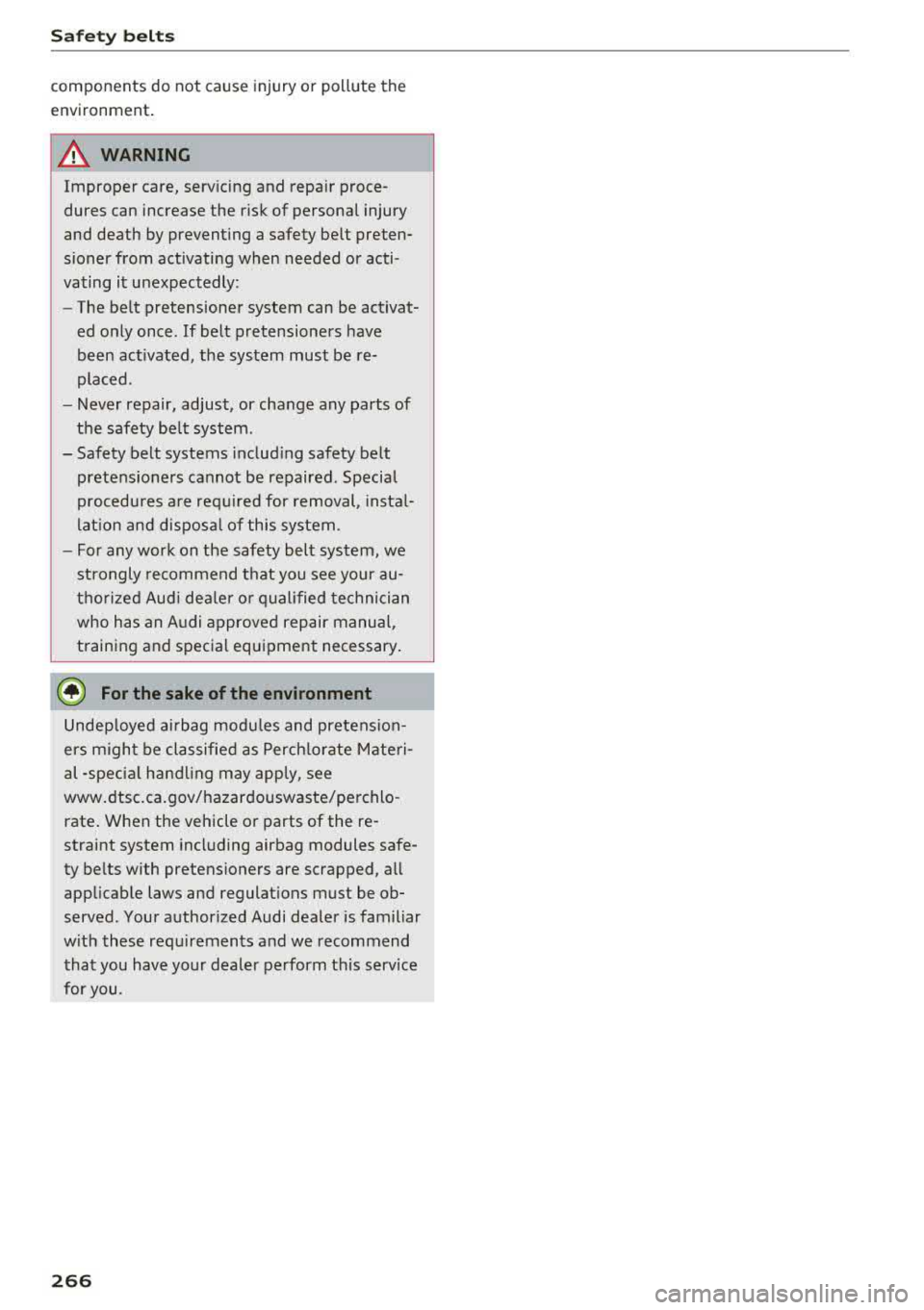
Safety belts
components do not cause injury or pollute the
environment .
A WARNING -
Improper care, servicing and repair proce
dures can increase the r isk of personal injury
and death by preventing a safety belt preten
sioner from activating when needed or acti
vating it unexpectedly:
- The belt pretensioner system can be activat
ed only once. If belt pretensioners have
been activated, the system must be re
placed.
- Never repair, adjust, or change any parts of
the safety belt system.
- Safety belt systems including safety belt
pretensioners cannot be repaired. Special
procedures are required for removal, instal
lation and disposal of this system.
- For any work on the safety belt system, we
strongly recommend that you see your au
thorized Audi dealer or qualified technician
who has an Audi approved repair manual,
training and special equipment necessary.
@ For the sake of the environment
Undeployed airbag modules and pretension
ers might be classified as Perchlorate Materi
al -speci al handling may apply, see
www.dtsc.ca.gov/hazardouswaste/ pe rchlo
rate. When the vehicle or parts of the re
straint system including airbag modules safe
ty belts with pretensioners are scrapped, all
applicable laws and regulations must be ob
served. Your authorized Audi dealer is familiar
with these requirements and we recommend
that you have your dealer perform this service
for you.
266
Page 270 of 400
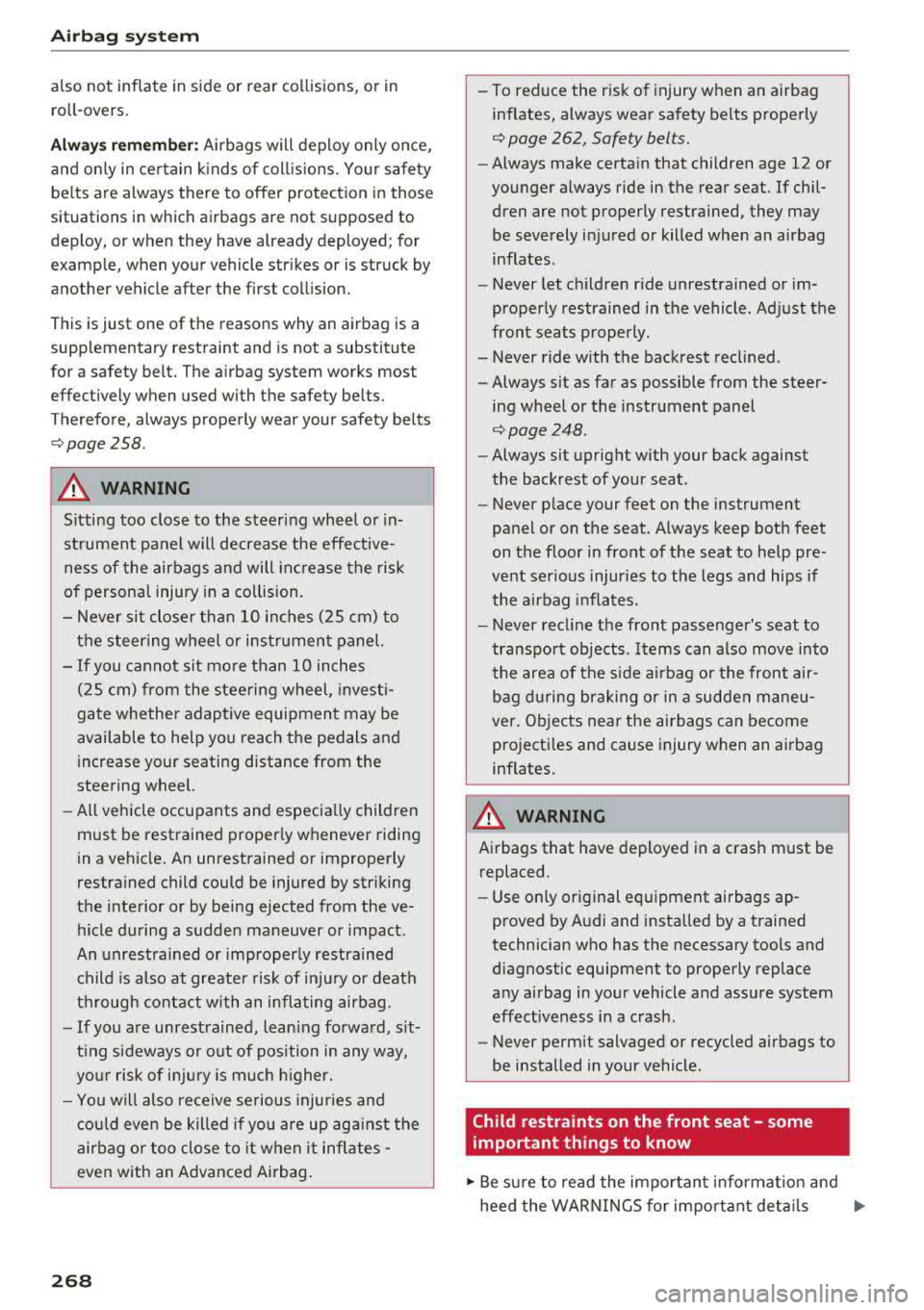
Airbag syste m
also not inflate in s ide or rear collisions, or in
ro ll-overs.
Al wa ys rememb er: Airbags will deploy only once,
and on ly in ce rtain k inds of coll is ions. Yo ur safety
be lts are always there to offer protection in those
situations in which airbags are not supposed to
dep loy, or when they have already deployed; for
examp le, when your vehicle str ikes or is struck by
another vehicle after the first coll is ion.
This is just one of the reasons why an airbag is a
supp lementary restraint and is not a substitute
for a safety belt. The a irbag system works most
effect ively when used with the safety belts.
Therefore, always properly wear your safety belts
r=;, page 258.
A WARNING
Sitting too close to the steering wheel o r in
st rument panel will decrease the effective
ness of the airbags and will inc rease the risk
of personal injury in a co llision.
- Never sit closer than 10 inches (25 cm) to
the steering wheel or instrument panel.
- If you cannot si t mo re than 10 inches
(25 cm) from the steering wheel, invest i
gate whether adaptive equipment may be
available to help yo u reach the pedals and
increase your seating distance from the
steering wheel.
- All veh icle occupants and especially children
must be restrained properly whenever riding
in a vehicle. An unrestrained or improperly
restra ined child could be injured by striking
the interior or by being ejected from the ve
hicle during a sudden maneuver or impact.
An unrestrained or imp roperly restrained
child is also at greate r risk of inju ry or death
through contact with an inflating airbag.
- If you are unrestrained, leaning fo rwa rd, s it
t ing s ideways or o ut o f pos ition in any way,
yo ur risk of in ju ry is much h igher.
- Yo u will also receive serious injuries and
c ould even be killed if you are up aga inst the
air bag or too close to it when it inflates
-
even with an Advanced Airbag.
2 6 8
-
- To reduce the ris k of i njury when an a irbag
inflates, always wea r safety belts properly
r=;, page 262, Safety belts.
- Always make certa in that children age 12 or
younger always ride in the rear seat. If chil
dren are not properly restrained, they may be severely injured or killed when an airbag
inflates.
- Never let ch ildren ride unrestra ined or im
properly restrained in the vehicle. Ad just the
front seats properly.
- Never ride with the back rest recl ined .
- Always sit as far as possible from the steer-
ing wheel or the instrument panel
r=;, page 248.
- Always sit upright w ith your back against
the backrest of your seat .
- Never p lace your feet on the instrument
panel or on the seat. Always keep both feet
on the floor in front of the seat to help pre
vent serious injur ies to the legs and hips if
the airbag inflates.
- Never recl ine the front passenger's seat to
transpo rt objects . Items can also move in to
the area of the s ide a irbag or the front air
bag du ring brak ing o r in a sudden maneu
ver. Obje cts nea r the airbags can become
projecti les and cause injury when an airbag
inflates.
A WARNING
A irbags that have deployed in a crash must be
replaced.
- Use on ly original equipment airbags ap
proved by Audi and installed by a trained
technician who has the necessary tools and
diagnostic equipment to properly replace
any airbag in your vehicle and assure system
effectiveness in a crash.
- Never perm it salvaged or recycled airbags to
be installed in your vehicle.
Child restraints on the front seat - some
important things to know
.,. Be s ure to read the impo rtant info rmat ion and
heed the WARN INGS for important deta ils
.,.
Page 272 of 400
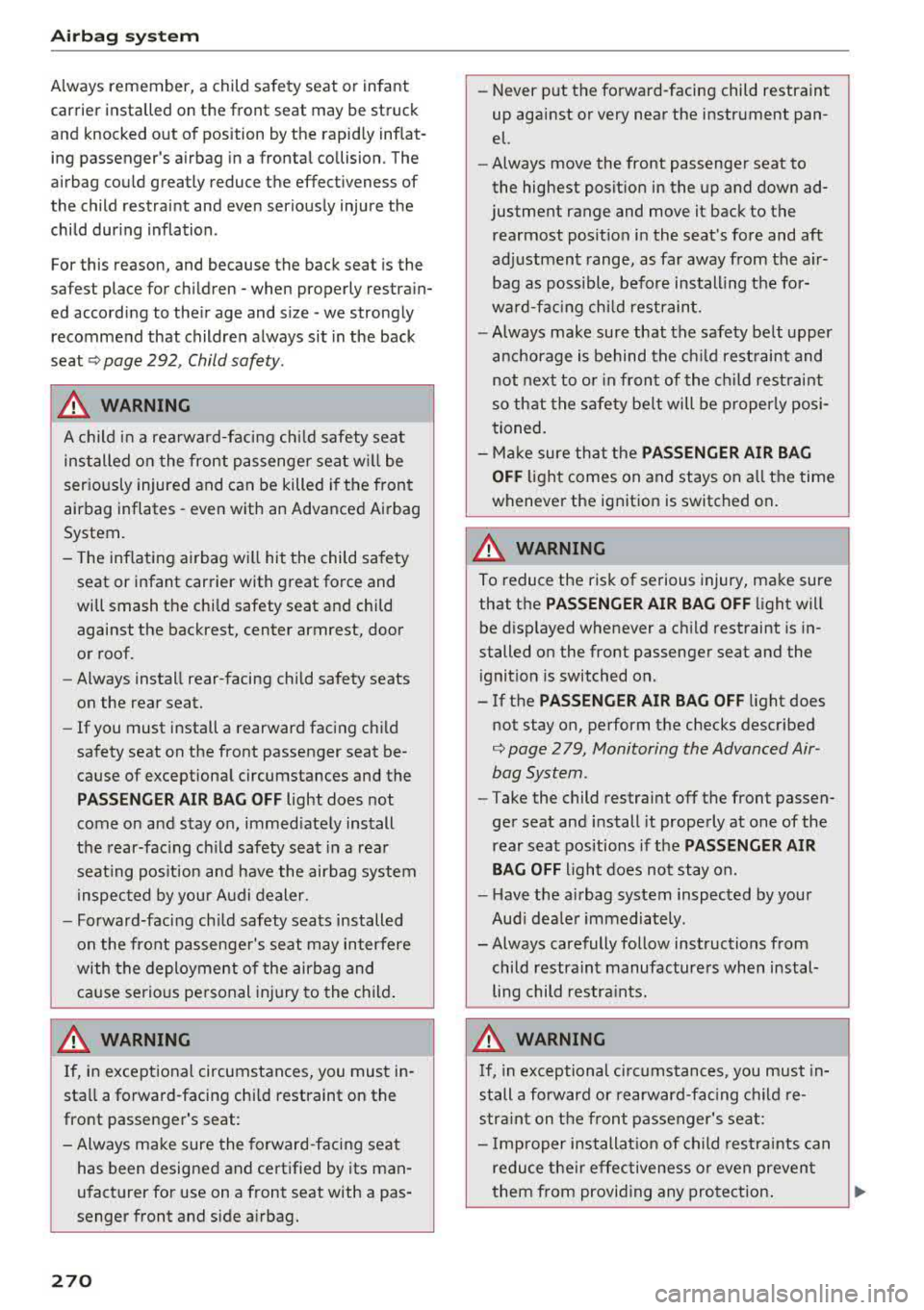
Airbag syste m
Always remember, a child safety seat or infant
carrier installed on the front seat may be struck
and knocked out of position by the rapidly inflat
ing passenger's airbag in a frontal collision. The
airbag could greatly reduce the effectiveness of
the child restraint and
even seriously injure the
child dur ing inflation.
For this reason, and because the back seat is the
safest place for children - when properly restrain
ed according to the ir age and size -we strongly
recommend that children always sit in the back
seat ¢ page 292, Child safety.
A WARNING
A child in a rearward-facing chi ld safety seat
installed on the front passenger seat w ill be
seriously injured and can be killed if the front
airbag inflates -
even with an Advanced Airbag
System.
- The inflating airbag will hit the child safety
seat or infant carrier with great force and
will smash the chi ld safety seat and child
against the backrest, center armrest, door
or roof.
- Always install rear-facing child safety seats
on the rear seat.
- If you must install a rearward facing chi ld
safety seat on the front passenger seat be cause of exceptional circumstances and the
PA SSENGER AIR BAG OFF light does not
come on and stay on, immed iately install
the rear-fac ing ch ild safety seat in a rear
seat ing pos ition and have the airbag system
inspected by your Audi dealer.
- Forward-facing ch ild safety seats installed
on the front passenger's seat may interfere
with the deployment of the airbag and ca use serio us personal injury to the child .
A WARNING
If, in exceptional circumstances, you must in
stall a forward-facing chi ld restraint on the
front passenger's seat:
- Always make sure the forward -facing seat
has been designed and ce rtified by its man
u facturer for use on a front seat with a pas
senger front and side a irbag.
270
- Never put the fo rward-facing child restraint
up against or
very near the instrument pan
el.
- Always move the front passenger seat to
the highest posit ion in the up and down ad
justment range and move it back to the rearmost posit ion in the seat's fore and aft
ad justment range, as far away from the a ir
bag as poss ible, before install ing the for
ward-facing chi ld restraint.
- Always make sure that the safety be lt upper
anchorage is behind the ch ild rest raint and
not next to o r in front of the child rest raint
so that the safety be lt will be properly posi
tioned.
- Ma ke sure that the
PASSENGER AIR BAG
OFF
light comes on and stays on a ll the time
wheneve r the ignit ion is switched on .
A WARNING
-
To reduce the risk of serious injury, make sure
that the
PASSENGER AIR BAG OFF light will
be d isp layed whenever a ch ild restraint is in
stalled on the front passenge r seat and the
ignition is switched on.
- If the
PASSENGER AIR BAG OFF light does
not stay on, perform the checks described
¢ page 2 79, Monitoring the Advanced Air
bag System .
-Take the child restraint off the front passen
ger seat and install it properly at one
of the
rear seat positions if the
PASSENGER AIR
BAG OFF
light does not stay on.
- Have the airbag system inspected by your
Aud i dea le r i mmediately.
- Always carefully follow instructions from child restraint manufacture rs when instal
ling child restra ints.
A WARNING
If, in exceptional ci rcumstances, you must in
stall a forward or rearward-fac ing child re
stra int on the front passenger's seat:
- Improper installat ion of child restr aints can
reduce the ir effectiveness or
even preven t
them from provi ding any pro te ct ion .